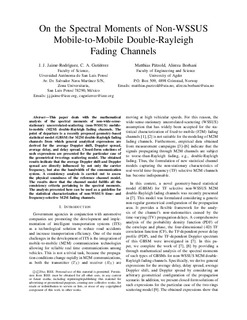| dc.contributor.author | Jaime-Rodriguez, J. J. | |
| dc.contributor.author | Gutierrez, Carlos Adrian | |
| dc.contributor.author | Pätzold, Matthias Uwe | |
| dc.contributor.author | Borhani, Alireza | |
| dc.date.accessioned | 2018-04-05T08:51:15Z | |
| dc.date.available | 2018-04-05T08:51:15Z | |
| dc.date.created | 2017-10-27T14:01:06Z | |
| dc.date.issued | 2018 | |
| dc.identifier.citation | Paper presented at the 2017 IEEE 28th Annual International Symposium on Personal, Indoor, and Mobile Radio Communications (PIMRC) | nb_NO |
| dc.identifier.isbn | 978-1-5386-3531-5 | |
| dc.identifier.issn | 2166-9570 | |
| dc.identifier.uri | http://hdl.handle.net/11250/2492760 | |
| dc.description.abstract | This paper deals with the mathematical analysis of the spectral moments of non-wide-sensestationary uncorrelated-scattering (non-WSSUS) mobile-to-mobile (M2M) double-Rayleigh fading channels. The point of departure is a recently proposed geometry-based statistical model (GBSM) for M2M double-Rayleigh fading channels from which general analytical expressions are derived for the average Doppler shift, Doppler spread, average delay, and delay spread. Closed-form solutions of such expressions are presented for the particular case of the geometrical two-rings scattering model. The obtained results indicate that the average Doppler shift and Doppler spread are directly influenced by not only the carrier frequency, but also the bandwidth of the communication system. A consistency analysis is carried out to assess the physical soundness of the reference channel model. The results show that the channel model fulfills all the consistency criteria pertaining to the spectral moments. The analysis presented here can be used as a guideline for the statistical characterization of non-WSSUS time- and frequency-selective M2M fading channels. | nb_NO |
| dc.language.iso | eng | nb_NO |
| dc.publisher | IEEE | nb_NO |
| dc.relation.ispartofseries | IEEE International Symposium on Personal, Indoor, and Mobile Radio Communications workshops;2017 | |
| dc.relation.uri | http://ieeexplore.ieee.org/document/8292464/ | |
| dc.title | On the spectral moments of non-WSSUS mobile-to-mobile double Rayleigh fading channels | nb_NO |
| dc.type | Journal article | nb_NO |
| dc.type | Peer reviewed | nb_NO |
| dc.description.version | acceptedVersion | nb_NO |
| dc.source.pagenumber | 1-6 | nb_NO |
| dc.identifier.doi | 10.1109/PIMRC.2017.8292464 | |
| dc.identifier.cristin | 1508374 | |
| dc.relation.project | Norges forskningsråd: 261895 | nb_NO |
| dc.description.localcode | nivå1 | nb_NO |
| cristin.unitcode | 201,15,4,0 | |
| cristin.unitname | Institutt for informasjons- og kommunikasjonsteknologi | |
| cristin.ispublished | true | |
| cristin.fulltext | postprint | |
| cristin.qualitycode | 1 | |
